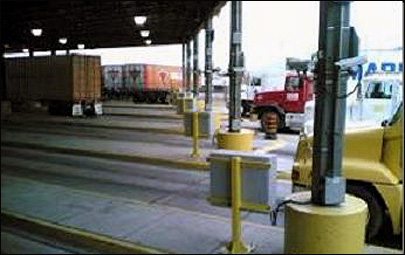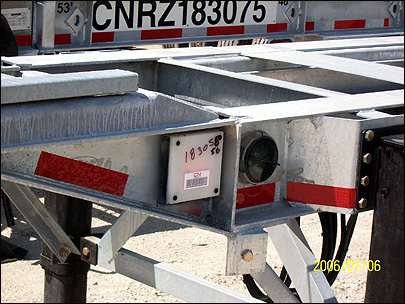Nov 15, 2006Last year, business was booming for the intermodal transportation services arm of the Canadian National Railway (CN). Increased usage of its intermodal freight transportation terminal in Brampton, Ontario, however—where cargo containers arrive on railcars and are transferred onto trailer chassis, after which trucks haul them away—was causing congestion. To alleviate this problem, the terminal turned to an RFID-based chassis-rental system that has not only freed up traffic at the facility's cargo-container storage area, but has also led to improvements in CN's chassis management. These improvements, combined with a reliable billing system, have generated a return on CN's RFID investment to the tune of a half-million Canadian dollars, according to Remy Benmiloud, CN's intermodal services product manager.
Before CN introduced the RFID-based chassis-rental system in May 2006, it had to dispatch cranes to remove the containers whenever trains rolled into the terminal. The cranes would pick up CN-owned containers from the railcars and place them onto chassis also owned by CN. At that time, the company owned only about 50 percent of the cargo containers on a typical train. The cranes would place the other containers either onto their respective owners' chassis or, if none were available, into storage and charge the shippers a per diem for this service. In some cases, if storage areas were filled up, the terminal would need to lift the containers temporarily onto CN chassis until an appropriate chassis or storage spot became available. This would cost the terminal time and money without contributing to its productivity.

CN knew the only way shippers would accept a move to a chassis-rental pool—in which all containers would be placed on CN-owned chassis and shippers would pay fees for the use of the chassis—was if it improved the turnaround time needed to unload containers and move them onto a chassis and out of the terminal more efficiently. To that end, CN needed to find a reliable means of identifying each chassis, associating it with the company renting it, and recording its return to the facility. In addition, CN required a reliable means of associating the chassis with the renter, to avoid losing the $20,000-plus pieces of equipment to theft.
Benmiloud says he knew a manual system would not work. One reason for his skepticism was the expectation that the act of manually entering data was prone to too many errors. In addition, the ID number, painted on an I-beam running along each chassis, was not always easy to see—inclement weather and other factors sometimes resulted in terminal personnel not always being able to read it easily.
Therefore, the company turned to Bell Canada, which worked with Staples Business Depot last year to deploy an RFID product-tracking pilot test (see Staples Business Depot Sees Big Benefits From RFID Test), to help design an RFID solution for identifying the chassis. Bell Canada brought RFID hardware provider Symbol Technologies and RFID solutions provider Shipcom Wireless into the project.
CN initiated a pilot program last winter, which it rolled out across its Brampton facility this past May. Symbol provided a rugged, large-form-factor EPC Gen 2 passive Cargo tag—which, at that time, was still in development, but which Symbol has just released—and worked with Bell Canada and CN to determine how best to mount the tag onto the chassis, and where to position readers and antennas to read the tag as the chassis moves into and out of the terminal. Symbol also worked with Bell Canada to ensure consistent linkages between the readers and the Shipcom middleware, which would be installed not onsite, but at a main IT center CN operates 400 miles away, in Montreal.
As workers drive the trucks out of the yard, Symbol XR400 readers, mounted inside protective boxes located next to each of nine exit lanes in the terminal, read the tags and send their data to Shipcom middleware. The middleware sends the chassis number to a computer inside the gatehouse, where it automatically appears in the chassis-number field of a chassis-rental form. The gatehouse operator then views a video screen linked to cameras that pick up the ID numbers marked on the containers), keys in the proper container number and sends the complete rental form, including the date and time of rental, to CN's back-end chassis rental and billing systems. When the rental chassis returns to the yard, interrogators posted around the entrance gates read its tag and send the ID and the date and time of return to the middleware. The middleware transmits it to the back-end system, which marks the chassis as returned and completes the billing process.
While CN did not previously rent chassis to shippers, it did send many out of the terminal each day with CN trucks. Keeping track of those chassis was difficult; a gatehouse worker unable to see the ID painted on a chassis' I-beam clearly might fail to record it as the truck left the facility. Since CN often did not know where all of its chassis were at any given time, the Brampton facility needed to replace missing chassis on a regular basis. At times, more than 100 chassis could be unaccounted for, says Benmiloud.
Today, the company can account for nearly all its chassis at all times. As such, it has been able to avoid buying new chassis, and to reduce the size of its chassis inventory. This, Benmiloud says—combined with revenue generated by the chassis pool and a billing system markedly more reliable and accurate than the one it had used for storage fees before developing the pool—has enabled CN to earn a return on its RFID investment approaching C$500,000.
More importantly, says Benmiloud, CN's intermodal customers are more satisfied because the streamlined transfers of cargo containers from rail to truck and out of the terminal gates have led to more on-time shipments. In addition, its customers no longer worry about inaccurate bills.
"Customers used to have resources dedicated to checking our billing," says Benmiloud. "Now they don't want to do that."
In the future, CN would like to replicate this chassis-pool rental system at its other intermodal facilities throughout Canada (the company operates a total of nine) and is also looking to expand the use of RFID at its Brampton terminal. Tagging the containers and placing readers on the cranes that lift them would enable CN to improve its method of tracking its customers' incoming and outgoing shipments. Benmiloud says the company is presently considering security applications based on the RFID system.


